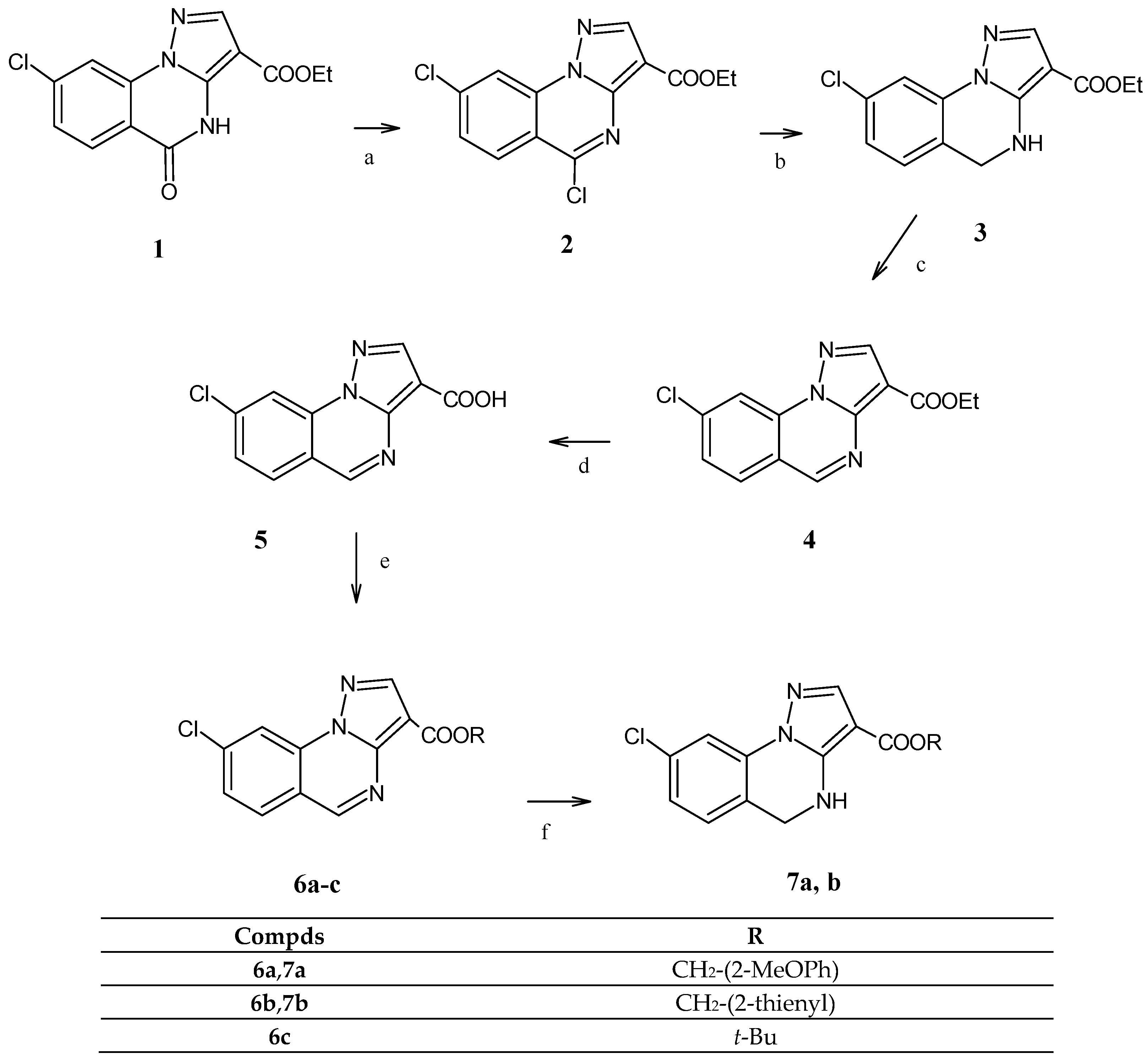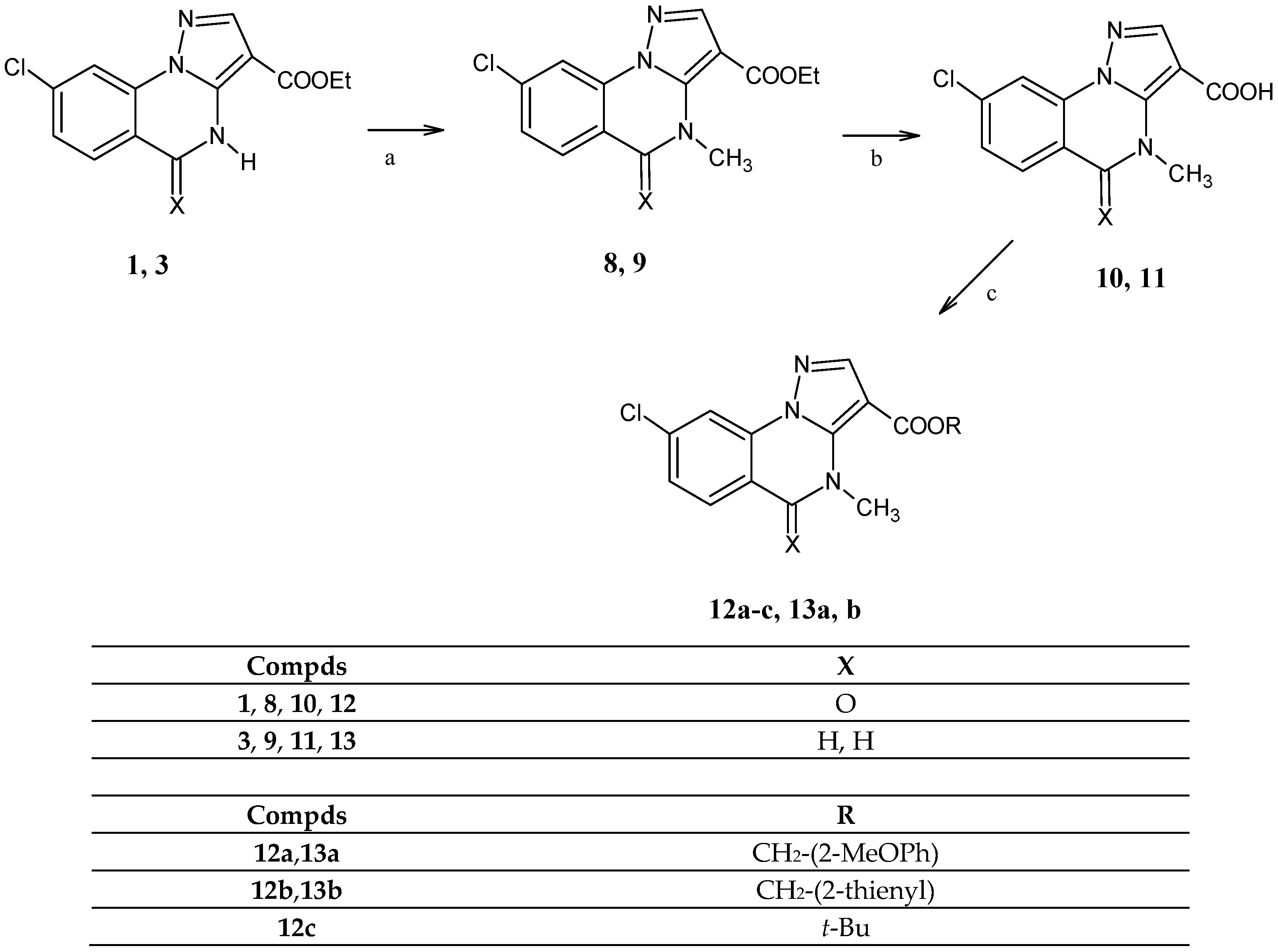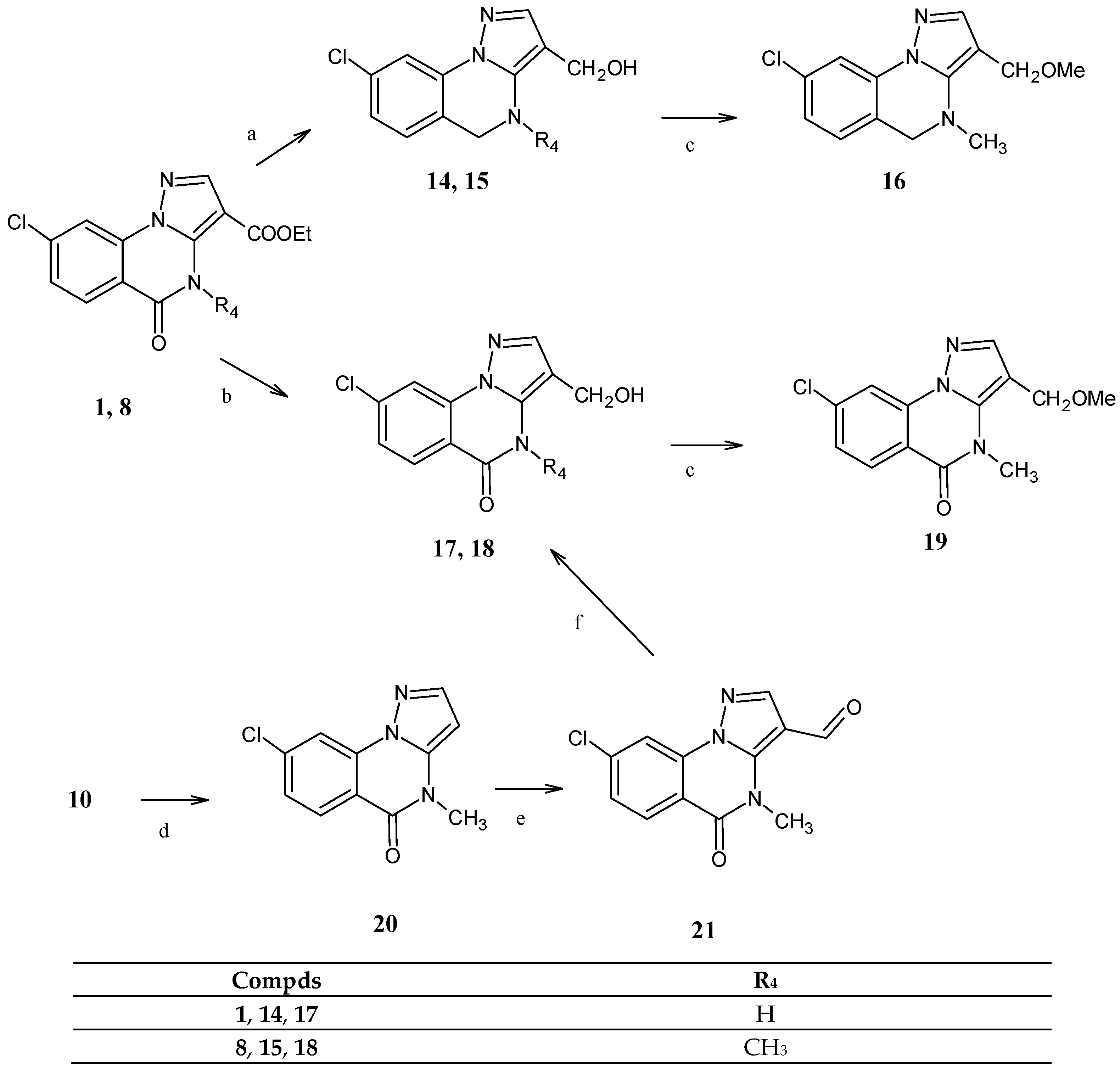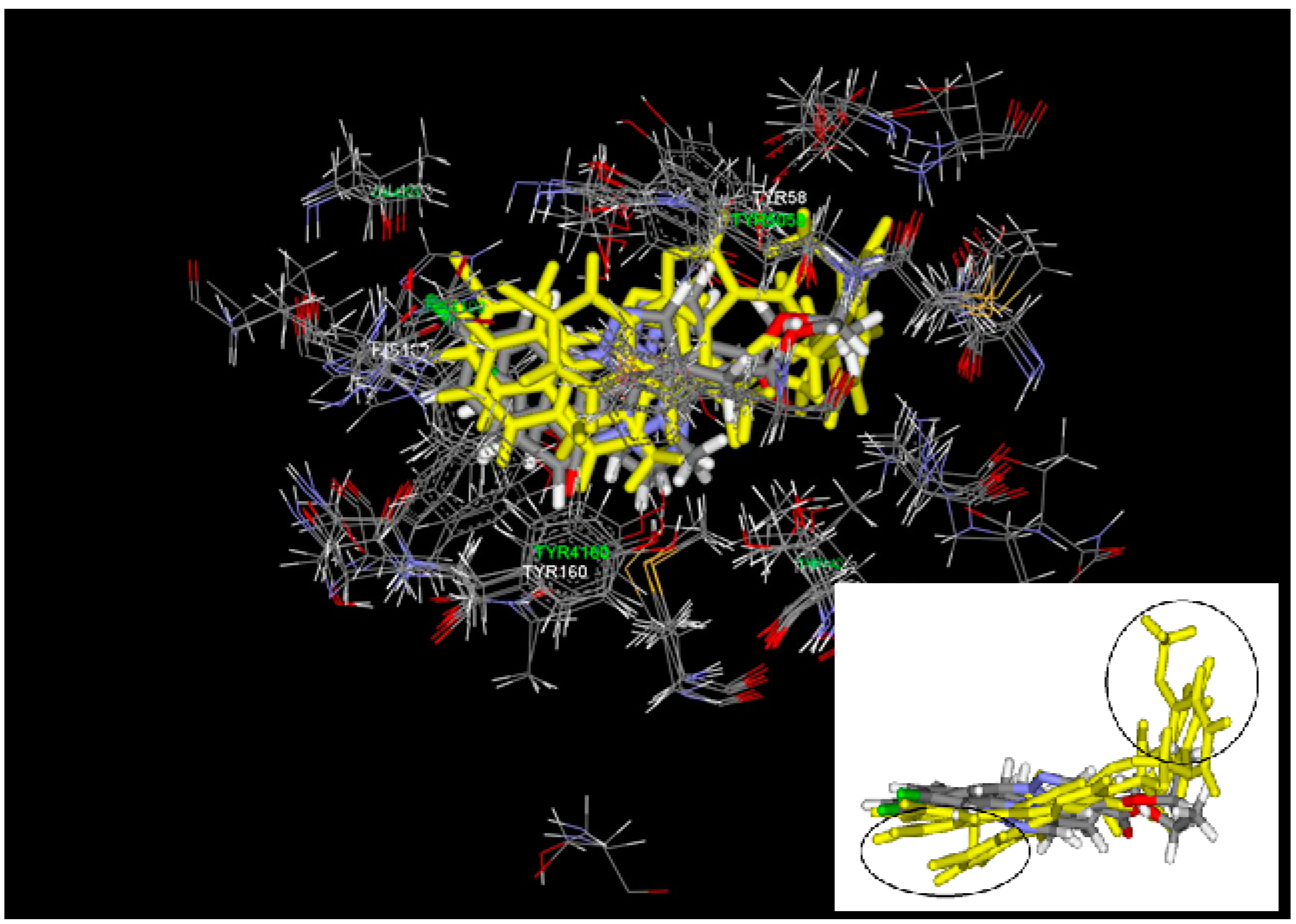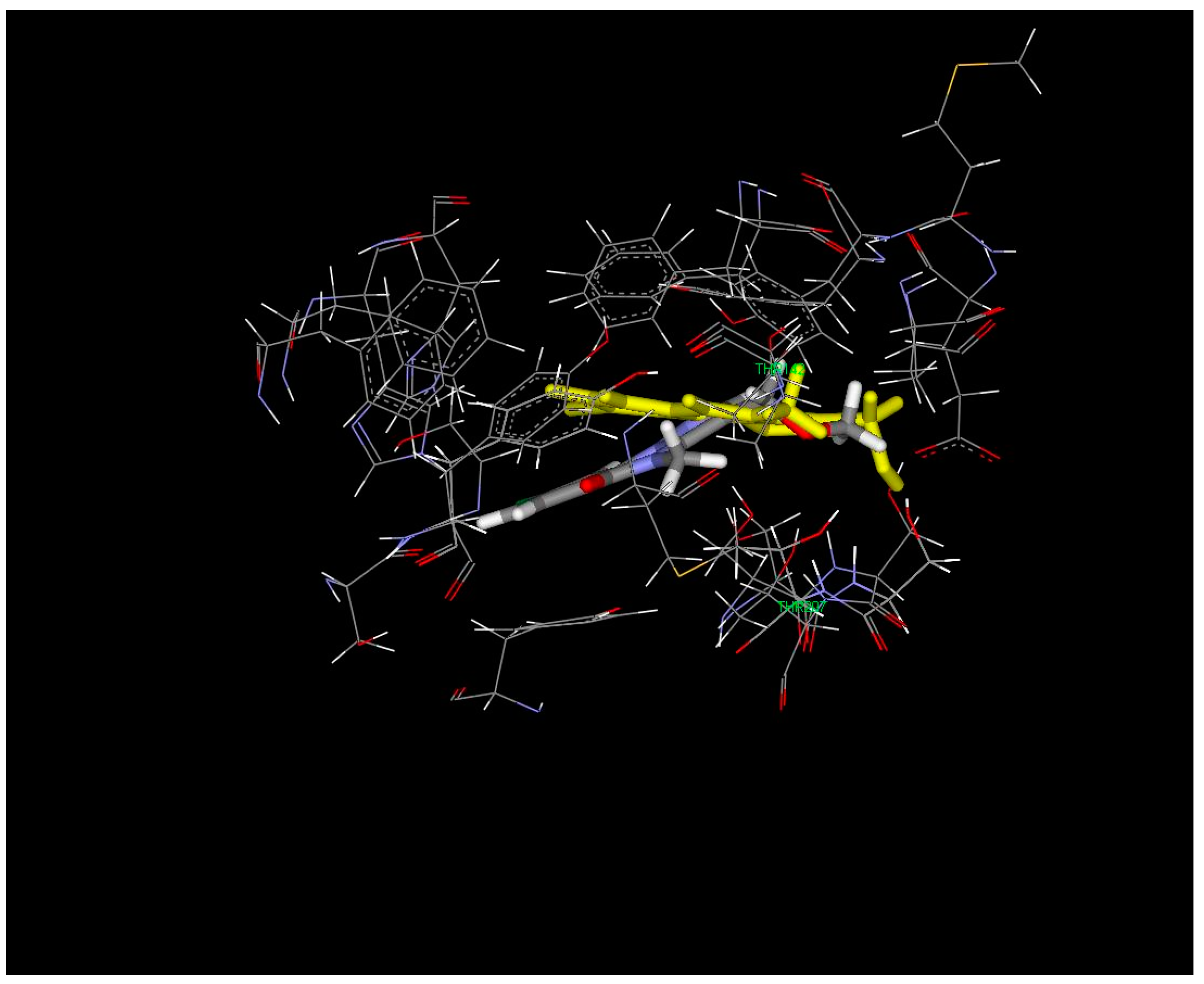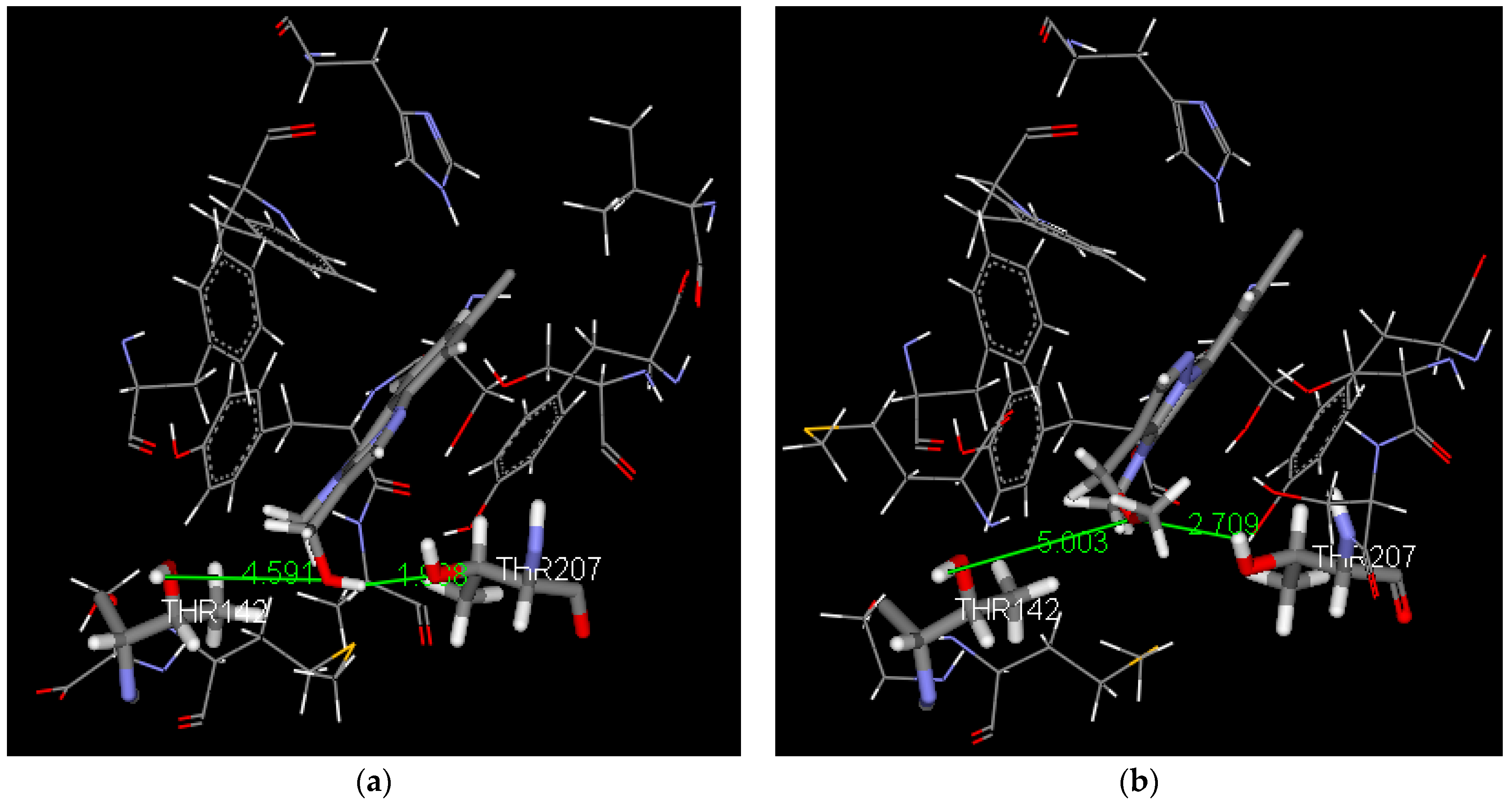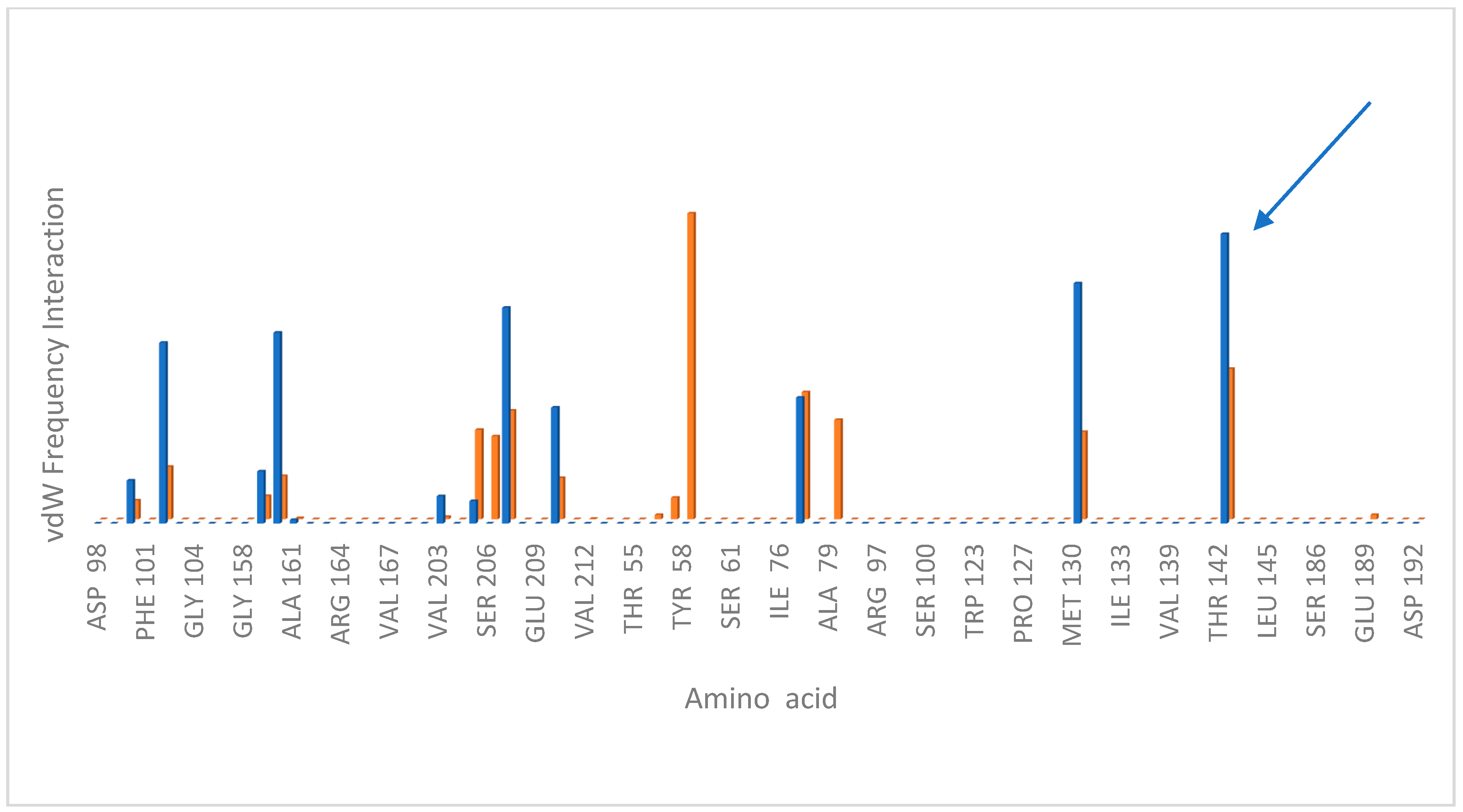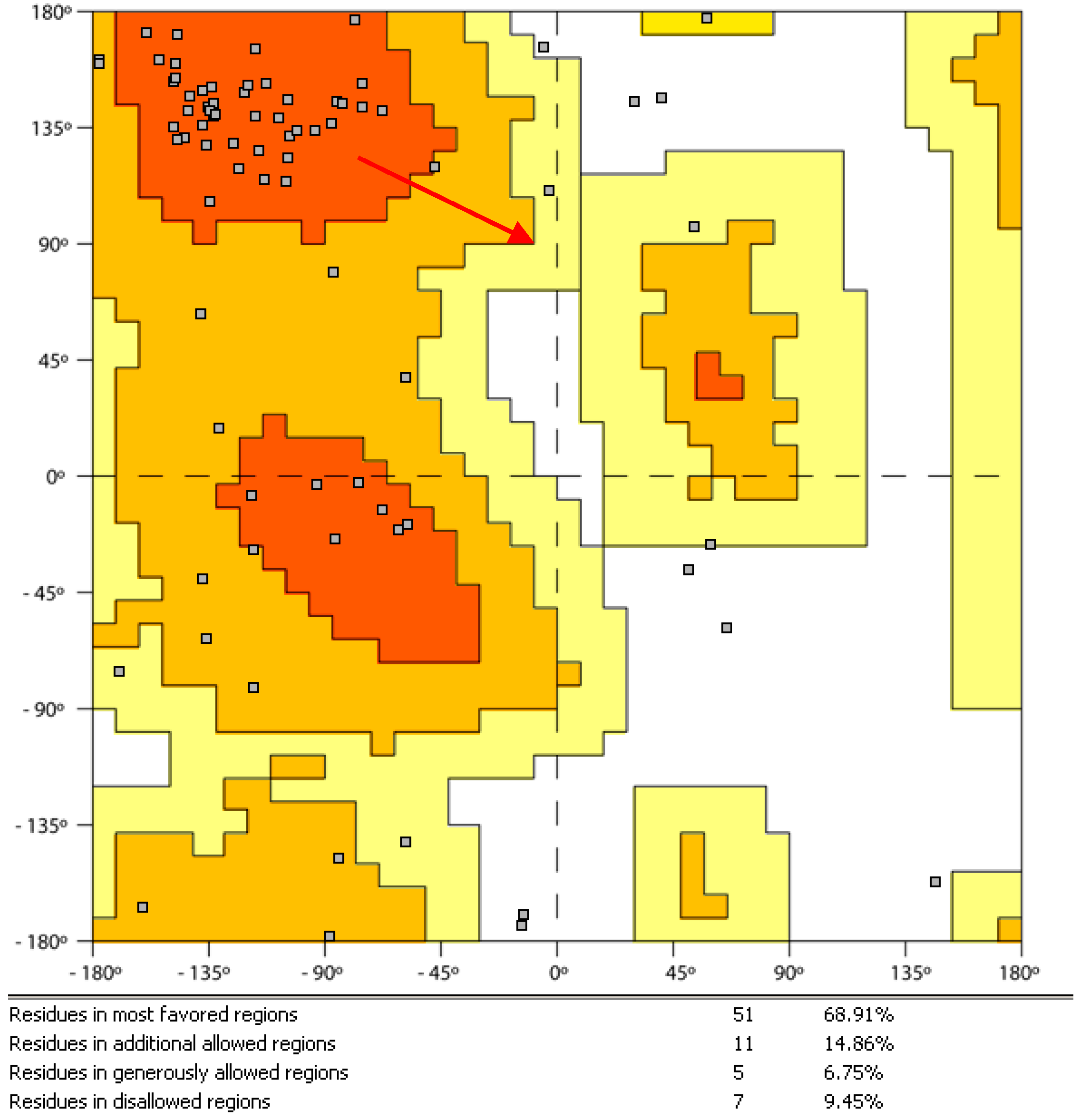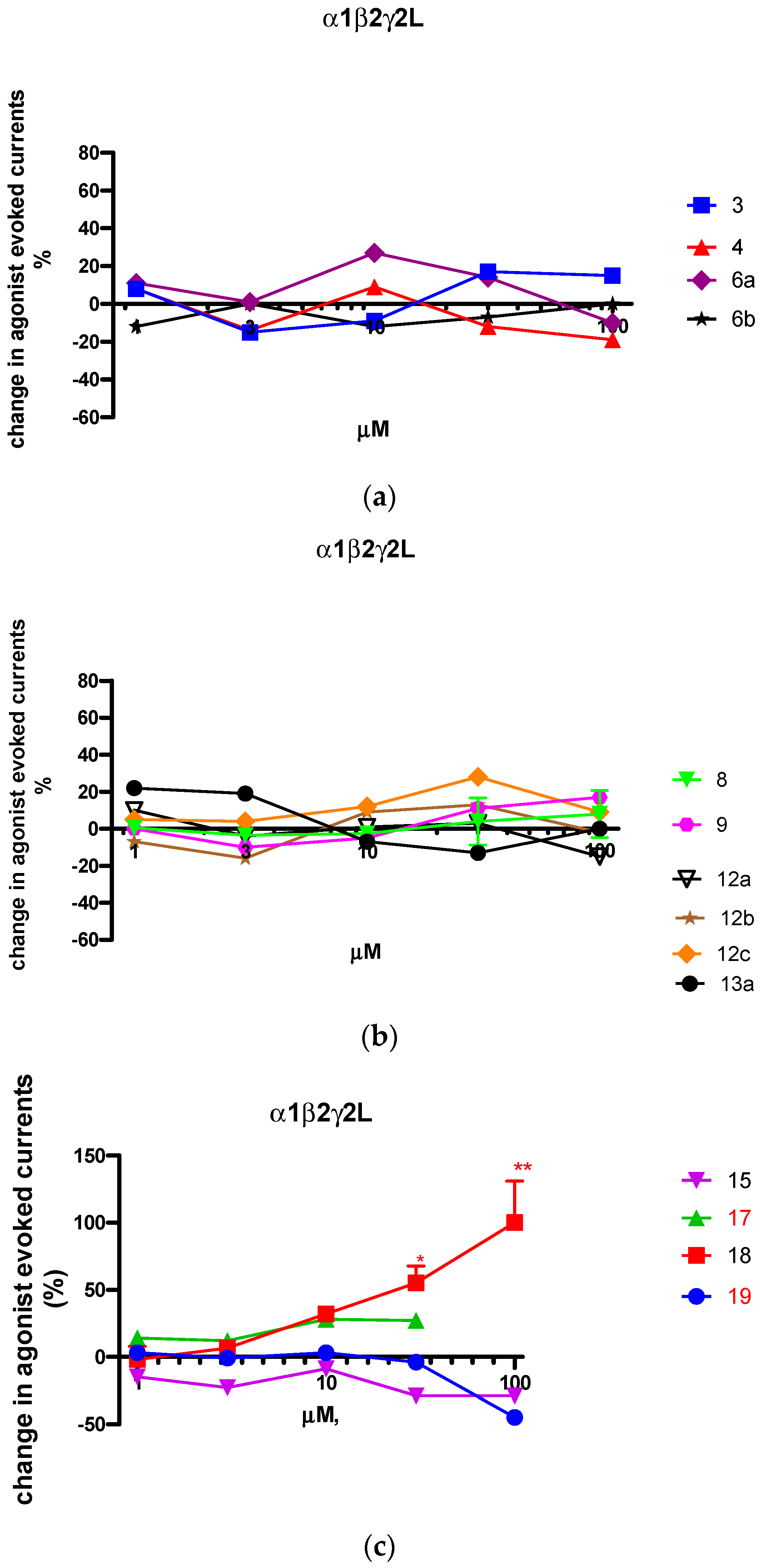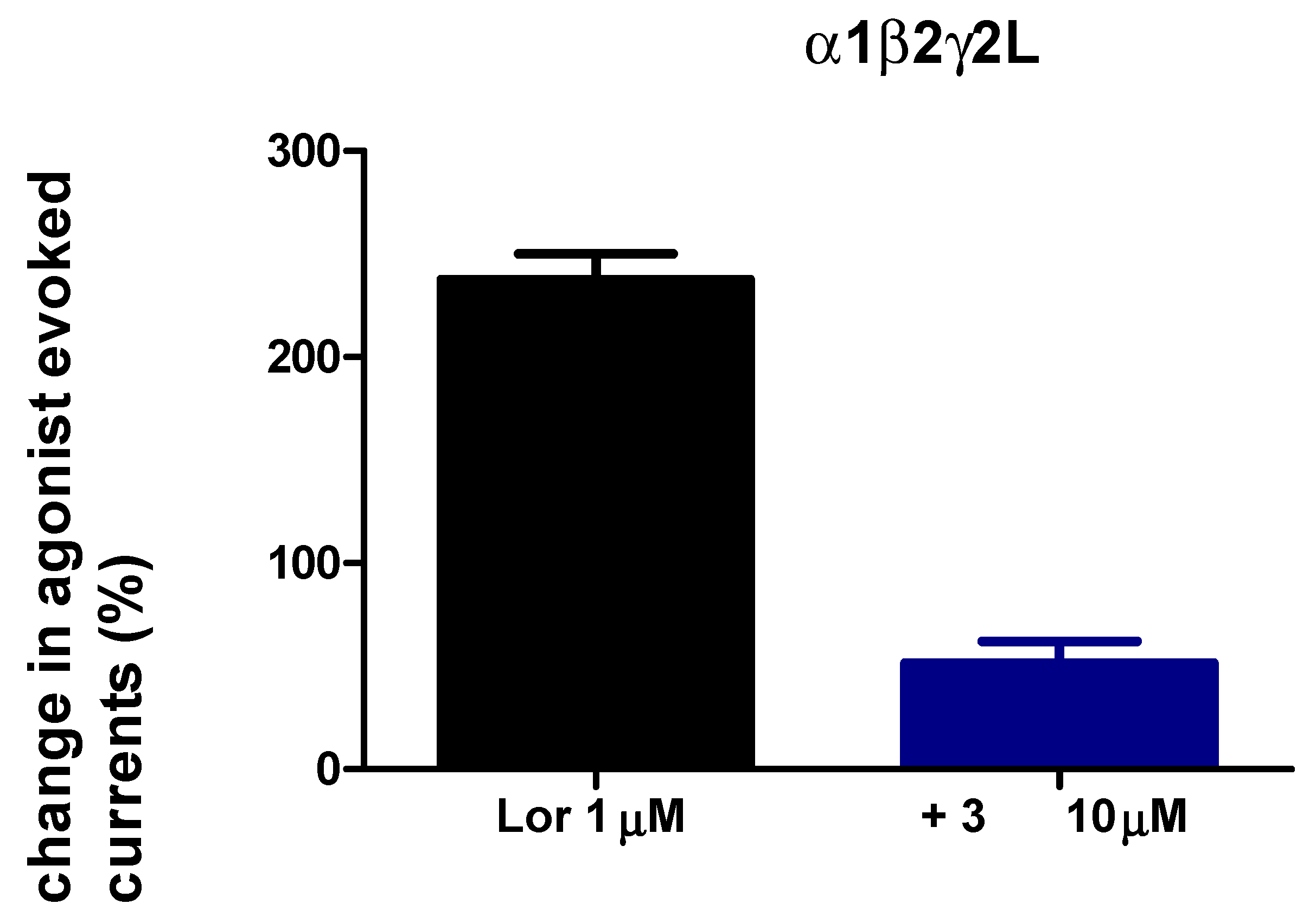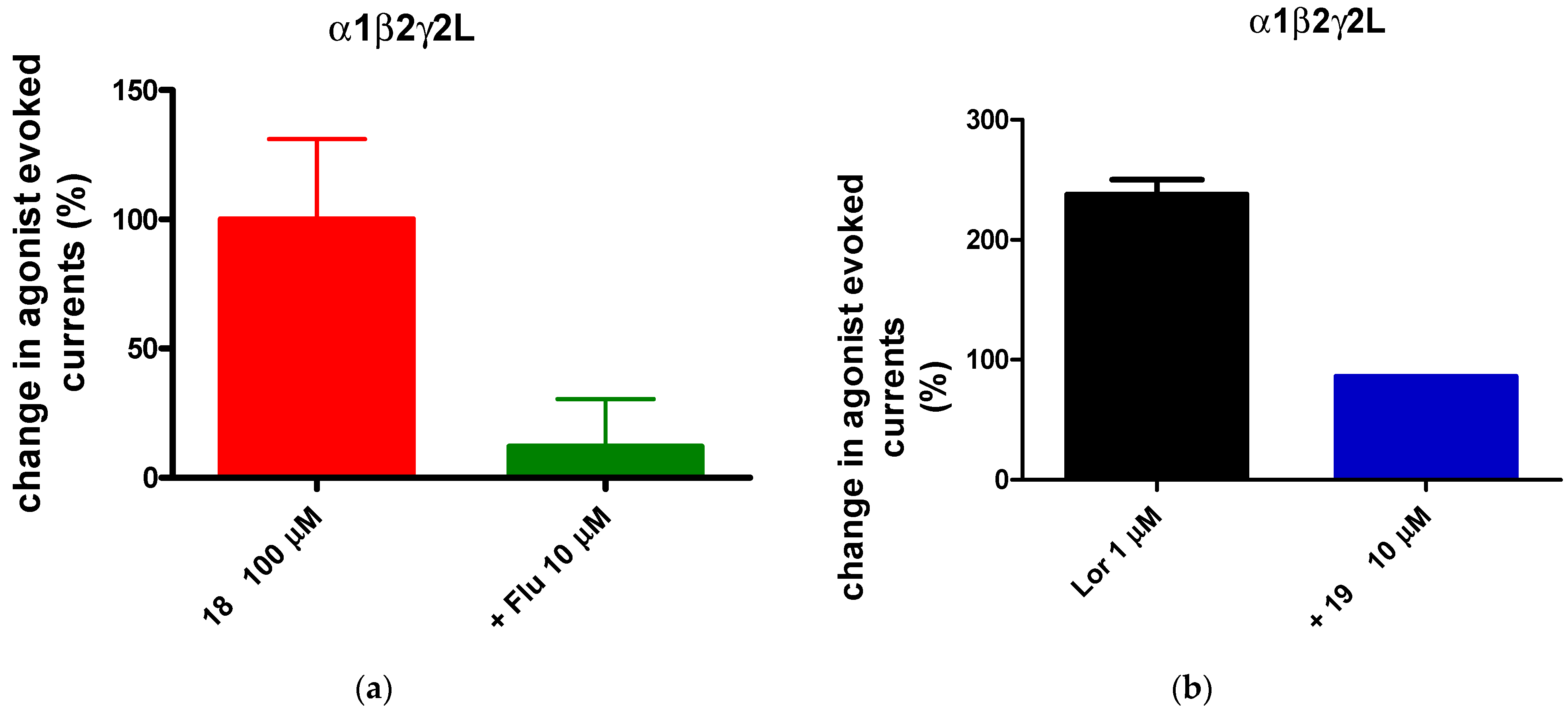Reagents and starting materials were obtained from commercial sources. Extracts were dried over Na2SO4, and the solvents were removed under reduced pressure. All reactions were monitored by thin layer chromatography (TLC) using commercial plates pre-coated with Merck silica gel 60 F-254. Visualization was performed by UV fluorescence (λmax = 254 nm) or by staining with iodine or potassium permanganate. Chromatographic separations were performed on a silica gel column by gravity chromatography (Kieselgel 40, 0.063–0.200 mm; Merck, Kenilworth, NJ, USA), flash chromatography (Kieselgel 40, 0.040–0.063 mm; Merck) and silica gel preparative TLC (Kieselgel 60 F254, 20 × 20 cm, 2 mm). Yields refer to chromatographically and spectroscopically pure compounds, unless otherwise stated. Compounds were named following IUPAC rules, as applied by Beilstein-Institut AutoNom 2000 (4.01.305) or CA Index Name. All melting points were determined on a hot-stage Büchi microscope and are uncorrected. The identity and purity of intermediates and final compounds were ascertained through 1H-NMR, 13C-NMR and TLC chromatography. Monodimensional spectra 1H-NMR and 13C-NMR were registered by a 400 MHz field through Avance 400 apparatus (Bruker Biospin Version 002 with SGU). Chemical shifts (d) are in parts per million (ppm) approximated by the nearest 0.01 ppm, using the solvent as internal standard. Coupling constants (J) are in Hz; they were calculated by Top Spin 3.1 and approximated by 0.1 Hz. Data are reported as follows: chemical shift, multiplicity (exch, exchange; br, broad; s, singlet; d, doublet; t, triplet; q, quartet; m, multiplet; or a combination of those, e.g., dd), integral, assignments and coupling constant. Mass spectra (m/z) were recorded on an ESI-MS triple quadrupole (Varian 1200 L) system, in positive ion mode, by infusing a 10 mg/L solution of each analyte dissolved in a mixture of mQ H2O:acetonitrile 1:1 v/v. All new compounds possess a purity ≥95%; microanalyses indicated by the symbols of the elements were performed with a Perkine-Elmer 260 elemental analyzer for C, H and N, and they were within ±0.4% of the theoretical values.
3.1. Chemistry
Ethyl 5,
8-dichloropyrazolo[1,
5-a]quinazoline-3-carboxylate(2). The starting material, ethyl 8-chloro-5-oxo-4,5-dihydropyrazolo[1,5-a]quinazoline-3-carboxylate [
10] (0.6 mmol), was solubilized in 3 mL of POCl
3 and PCl
5 (75 mg) and maintained at refluxing temperature for 2 h, monitoring the reaction by TLC. Then the solution was evaporated to dryness, and the residue was treated with ice/water, obtaining a slightly yellow residue that was filtered. The raw material was pure enough for the next reaction. Recrystallization solvent: ethanol; yield 66%; mp 178–181 °C. TLC: toluene/ethyl acetate/acetic acid 8:2:2
v/
v/
v; IR ν cm
−1 1718, 1597, 1270, 1057;
1H-NMR (400 MHz, DMSO-d
6) δ 8.61 (s, 1H, H-2); 8.46 (d, 1H, H-9,
J = 2.0 Hz); 8.33 (d, 1H, H-6,
J = 8.8 Hz); 7.84 (dd, 1H, H-7,
J1 = 8.8 Hz,
J2 = 2.0 Hz); 4.31 (q, 2H, CH
2,
J = 7.2 Hz); 1.31 (t, 3H, CH
3,
J = 7.2 Hz). ESI-MS calcd for C
13H
9N
3O
2Cl
2 (309.01); found: 311.00
m/
z [M + H]
+.Anal. C
13H
9N
3O
2Cl
2 (C, H, N).
Ethyl 8-chloro-4,5-dihydropyrazolo[1,5-a]quinazoline-3-carboxylate (3). ethyl 5,8-dichloropyrazolo[1,5-a]quinazoline-3-carboxylate 2 (0.1 g, 0.32 mmol) was dissolved In a solution of ethanol (12 mL) and dichlorometane (7 mL) and sodium borohydride (0.12 g, 3.14 mmol) was added in small portions. The reaction was maintained at room temperature for 30′, and the disappearance of the starting material was monitored by TLC. The evaporation of solvent to dryness gave a residue that was recovered with ethanol 80%, filtered and recrystallized by ethanol, yield 75%, cream crystals, mp 182–183 °C. TLC: toluene/ethyl acetate/methanol 8:2:1.5 v/v/v; IR ν cm−1 3100, 1718, 1270, 1057; 1H-NMR (400 MHz, CDCl3) δ 7.71 (s, 1H, H-2); 7.25 (s, 1H, H-9); 7.11 (dd, 1H, H-7, J1 = 8.0 Hz, J2 = 2.0 Hz); 7.04 (d, 1H, H-6, J = 8.0 Hz); 5.94 (exch br s, 1H, NH); 4.61 (s, 2H, CH2); 4.28 (q, 2H, CH2, J = 6.8 Hz); 1.33 (t, 3H, CH3, J = 6.8 Hz). 13C-NMR (100 MHz, DMSO-d6) δ 162.86, 148.78, 142.59, 135.50, 133.20, 129.08, 125.59, 113.72, 94.90, 42.33, 14.96. ESI-MS calcd for C13H12N3O2Cl (277.71); found: 279.06 m/z [M + H]+. Anal. C13H12N3O2Cl (C, H, N).
Ethyl 8-chloropyrazolo[1,5-a]quinazoline-3-carboxylate (4). ethyl 8-chloro-4,5-dihydropyrazolo[1,5-a]quinazoline-3-carboxylate 3 (0.1 g, 0.36 mmol) was dissolved in 25 mL of toluene and Pd/C 10% (0.03 g) was added. The reaction was refluxed for 24 h and then the catalyst was filtered off. The solution was evaporated to dryness and the white residue was recovered with water, filtered and recrystallized by ethanol, yield 57%; mp 170–172 °C. TLC: toluene/ethyl acetate/methanol 8:2:1.5 v/v/v; IR ν cm−1 1718, 1270, 1057; 1H-NMR (400 MHz, CDCl3) δ 9.13 (s, 1H, H-5); 8.53 (m 2H, H-2 and H-9); 7.97 (d, 1H, H-6, J = 8.4 Hz); 7.59 (d, 1H, H-7, J = 8.0 Hz); 4.45 (q, 2H, CH2, J = 6.8 Hz); 1.48 (t, 3H, CH3, J = 6.8 Hz). 13C-NMR (100 MHz, DMSO-d6) δ 162.89, 155.54, 144.54, 142.32, 134.71, 133.45, 129.08, 125.98, 119.87, 114.72, 113.70, 94.98, 59.52, 14.16. ESI-MS calcd for C13H10N3O2Cl (275.69); found: 277.04 m/z [M + H]+. Anal. C13H10N3O2Cl (C, H, N).
8-Chloropyrazolo[1,5-a]quinazoline-3-carboxylic acid (5). The ester 4 (0.1 g, 0.36 mmol) was dissolved in a few drops of diglyme and then 10 mL of 15% sodium hydroxide solution was added and refluxed for 2.5 h. The final suspension was diluted with water, acidified with HCl conc. until pH = 1, and the precipitate recovered by filtration was pure enough for the next step. Recrystallized solvent: ethanol, yield 78%; mp 277–280 °C. TLC: toluene/ethyl acetate/acetic acid 8:2:1 v/v/v; IR ν cm−1 3475, 1685; 1H-NMR (400 MHz, DMSO-d6) δ 12.62 (exch br s, 1H, OH); 9.33 (s, 1H, H-5); 8.57 (s, 1H, H-2); 8.41 (s, 1H, H-9); 8.33 (d, 1H, H-6, J = 8.4 Hz); 7.80 (d, 1H, H-7, J = 8.8 Hz). ESI-MS calcd for C11H6N3O2Cl (247.64); found: 249.01 m/z [M + H]+. Anal. C11H6N3O2Cl (C, H, N).
General procedure for obtaining compounds 6a–c. The carboxylic acid 5 (0.5 mmol) was transformed into the corresponding 3-carbonyl chloride by reaction with an excess of SOCl2 in anhydrous conditions. After the standard work-up, the residue was suspended in dichloromethane (6 mL), and the suitable alcohol (excess, 0.15 mL) was added; TLC monitored the reaction until the disappearance of the starting material. Then the final solution was evaporated to dryness, and the residue recuperated with isopropyl ether and recrystallized.
2-Methoxybenzyl 8-chloropyrazolo[1,5-a]quinazoline-3-carboxylate (6a). From 4 and methoxybenzyl alcohol; white crystals, recrystallized by ethanol, yield 59%; mp 223–226 °C. TLC: toluene/ethyl acetate/methanol 8:2:1.5 v/v/v; IR ν cm−1 1722, 1626, 1277, 1057; 1H-NMR (400 MHz, DMSO-d6) δ 9.32 (s, 1H, H-5); 8.54 (s, 1H, H-2); 8.36 (s, 1H, H-9); 8.30 (d, 1H, H-7, J = 8.4 Hz); 7.76 (d, 1H, Ph, J = 7.2 Hz); 7.29–7.35 (m, 2H, H-6 and Ph); 6.99 (d, 1H, Ph, J = 8.4 Hz); 6.90 (t, 1H, Ph, J = 7.2 Hz); 4.67 (s, 2H, OCH2); 3.80 (s, 3H, OCH3). 13C-NMR (100 MHz, DMSO-d6) δ163.53, 155.32, 146.13, 144.95, 140.48, 136.27, 136.27, 131.93, 131.21, 130.83, 128.70, 127.52, 125.72, 120.85, 117.89, 114.54, 111.71, 108.80, 56.01, 42.18. ESI-MS calcd for C19H14N3O3Cl (367.79); found: 369.07 m/z [M + H]+. Anal. C19H14N3O3Cl (C, H, N).
Thiophen-2-yl-methyl 8-chloropyrazolo[1,5-a]quinazoline-3-carboxylate (6b). From 4 and 2-thiophenmethanol; white crystals, recrystallized by isopropanol, yield 45%; mp 229–232 °C. TLC: toluene/ethyl acetate/methanol 8:2:1.5 v/v/v; IR ν cm−1 1730, 1626, 1277, 1057; 1H-NMR (400 MHz, DMSO-d6) δ 9.22 (s, 1H, H-5); 8.22 (s, 1H, H-2); 8.16 (d, 1H, H-6, J = 8.4 Hz); 8.09 (d, 1H, H-9, J = 2.0 Hz); 7.60 (dd, 1H, H-7, J1 = 8.4 Hz, J2 = 2.0 Hz); 7.57 (d, 1H, H-5 Thiophene, J = 5.2 Hz); 7.24 (d, 1H, H-3 Thiophene, J = 2.8 Hz); 7.03 (dd, 1H, H-4 Thiophene, J1 = 5.2 Hz, J2 = 2.8 Hz); 5.46 (s, 2H, OCH2). 13C-NMR (100 MHz, DMSO-d6) δ 163.56, 160.41, 155.38, 146.17, 140.51, 131.98, 129.54, 127.56, 123.50, 117.88, 114.59, 108.12, 63.15. ESI-MS calcd for C16H10N3O2SCl (343.79); found: 345.02 m/z [M + H]+. Anal. C16H10N3O2SCl (C, H, N).
tert-Butyl 8-chloropyrazolo[1,5-a]quinazoline-3-carboxylate (6c). From 4 and tert-butanol; white crystals, recrystallized by isopropanol, yield 48%; mp 228–231 °C. TLC: toluene/ethyl acetate/methanol 8:2:1.5 v/v/v; IR ν cm−1 1730, 1626, 1277, 1057; 1H-NMR (400 MHz, DMSO-d6) δ 9.34 (s, 1H, H-5); 8.56 (s, 1H, H-2); 8.40 (d, 1H, H-9, J = 2.0 Hz); 8.33 (d, 1H, H-6, J = 8.6 Hz); 7.79 (d, 1H, H-7, J = 8.6 Hz); 2.47 (s, 9H, (CH3)3). 13C-NMR (100 MHz, DMSO-d6) δ 164.32, 155.52, 146.15, 139.54, 131.97, 130.34, 127.56, 125.06, 124.76, 123.65, 114.58, 108.23, 84.12, 28.78. ESI-MS calcd for C15H14N3O2Cl (303.75); found: 305.07 m/z [M + H]+. Anal. C15H14N3O2Cl (C, H, N).
General procedure for obtaining compounds 7a-b. The starting esters 6a and 6b (0.240 mmol) were solubilized in glacial acetic acid under nitrogen flow. Then, 0.972 mmol of sodium cyanoborohydride (NaBH3CN) was added, and the reaction was refluxed for 1 h and monitored by TLC. The final solution was cooled at room temperature and water added until a precipitate was formed; the raw product was purified by recrystallization by a suitable solvent.
2-Methoxybenzyl 8-chloro-4,5-dihydropyrazolo[1,5-a]quinazoline-3-carboxylate (7a). White crystals, recrystallized by isopropanol, yield 50%; mp 168–170 °C. TLC: toluene/ethyl acetate/methanol 8:2:1 v/v/v; IR ν cm−1 1722, 1626, 1277, 1057; 1H-NMR (400 MHz, CD3CN-d3) δ 8.18 (m, 4H, H-2, H-9, H-7 and H-6); 7.50 (d, 1H, Ph, J = 8.0 Hz); 7.44 (d, 1H, Ph, J = 8.0 Hz); 7.21 (d, 1H, Ph, J = 8.4 Hz); 7.04 (t, 1H, Ph, J = 7.2 Hz); 5.46 (s, 2H, OCH2); 3.86 (s, 5H, OCH3, CH2NH). 13C-NMR (100 MHz, DMSO-d6) δ 166.45, 157.14, 156.82, 141.06, 138.99, 133.98, 132.77, 131.88, 131.43, 131.12, 130.56, 130.29, 129.45, 128.90, 116.48, 114.58, 65.98, 56.42, 55.08. ESI-MS calcd for C19H16N3O3Cl (369.81); found: 371.09 m/z [M + H]+. Anal. C19H16N3O3Cl (C, H, N).
Thiophen-2-yl-methyl 8-chloro-4,5-dihydropyrazolo[1,5-a]quinazoline-3-carboxylate(7b). White crystals, recrystallized by isopropanol, yield 45%; mp 229–232 °C. TLC: toluene/ethyl acetate/methanol 8:2:1.5 v/v/v; IR ν cm−1 1725, 1630, 1277, 1057; 1H-NMR (400 MHz, CD3CN-d3) δ 8.16 (d, 1H, H-6, J = 8.6 Hz); 8.15 (s, 1H, H-2); 8.14 (d, 1H, H-9, J = 2.0 Hz); 7.50 (dd, 1H, H-7, J1 = 8.6 Hz, J2 = 2.0 Hz); 7.44 (dd, 1H, H-5 Thiophene, J1 = 5.2 Hz, J2 = 1.2 Hz); 7.21 (d, 1H, H-3 Thiophene, J = 3.2 Hz); 7.03 (dd, 1H, H-4 Thiophene, J1 = 5.2 Hz, J2 = 3.2 Hz); 5.46 (s, 2H, OCH2); 3.85 (s, 2H, CH2NH). 13C-NMR (100 MHz, CD3CN-d3) δ 167.14, 155.23, 154.21, 140.06, 139.43, 138.18, 137.41, 135.53, 125.86, 124.63, 122.06, 119.74, 116.48, 114.32, 61.63, 58.47, 56.41. ESI-MS calcd for C16H12N3O2SCl (345.79); found: 347.03 m/z [M + H]+. Anal. C16H12N3O2SCl (C, H, N).
Ethyl-8-chloro-4-methyl-5-oxo-4,
5-dihydropyrazolo[1,
5-a]quinazoline-3-carboxylate (8). A suspension of
1 (0.34 mmoles) in DMF abs. (2.5 mL) and anhydrous potassium carbonate (0.34 mmoles) was maintained for 15 min under stirring at room temperature; then, methyl iodide (0.34 mmoles, 0.04 mL) was added and the reaction was heated at 80° C, monitored by TLC. After the starting material disappeared, water/ice was added and the precipitate was filtered under suction and purified by recrystallization with ethanol. White crystals, yield 90 %; mp 159–161 °C. TLC: toluene/ethyl acetate/methanol 8:2:1.5
v/
v/
v;
1H-NMR (400 MHz, CDCl
3) δ 8.27 (s, 1H, H-2); 8.18 (d, 1H, H-6,
J = 8.4 Hz); 8.12 (d, 1H, H-9,
J = 1.2 Hz); 7.62 (dd, 1H, H-7,
J1 = 8.0 Hz,
J2 = 1.6 Hz); 4.26 (q, 2H, CH
2,
J = 7.0 Hz); 3.80 (s, 3H, NCH
3); 1.31 (t, 3H, CH
3,
J = 7.0 Hz). ESI-MS calcd for C
14H
12N
3O
3Cl (305.72); found: 307.05
m/
z [M + H]
+. Anal. C
14H
12N
3O
3Cl (C, H, N). [
10]
Ethyl 8-chloro-4-methyl-4,5-dihydropyrazolo[1,5-a]quinazoline-3-carboxylate (9). A suspension of 3 (0.35 mmoles) in tert-butanol (4.0 mL) and a 60% sodium hydride dispersion in mineral oil (2.92 mmoles) was maintained for 15 min under stirring at room temperature; then, methyl iodide (0.36 mmoles, 0.05 mL) was added and the reaction was refluxed, monitoring the reaction by TLC. After the starting material disappeared, water/ice and HCl 1.5N were added, and the aqueous phase was extracted with ethyl acetate. After the normal work-up, the residue was recovered with ethanol and recrystallized by the same solvent. White crystals, yield 38%; mp 152–154 °C. TLC: toluene/ethyl acetate/methanol 8:2:1.5 v/v/v; IR ν cm−1 3475, 1685; 1H-NMR (400 MHz, CDCl3) δ 7.80 (s, 1H, H-2); 7.50 (d, 1H, H-6, J = 8.0 Hz); 7.39–7.42 (m, 2H, H-9, H-7); 4.45 (s, 2H, CH2N); 4.30 (q, 2H, CH2, J = 7.2 Hz); 2.52 (s, 3H, NCH3); 1.38 (t, 3H, CH3, J = 7.2 Hz). ESI-MS calcd for C14H14N3O2Cl (291.74); found: 293.07 m/z [M + H]+. Anal. C14H14N3O2Cl (C, H, N).
General procedure for the synthesis of 10 and 11. A suspension of 8 or 9 (0.35 mmoles) in 10% sodium hydroxide solution (5 mL) was refluxed under stirring for 1 h, monitoring the reaction by TLC. After the starting material disappeared, water/ice and HCl 6N were added, and the precipitate was filtered under suction.
8-Chloro-4-methyl-5-oxo-4,
5-dihydropyrazolo[1,
5-a]quinazoline-3-carboxylic acid (10). From
8; white crystals, yield 80%; mp 234–237 °C. TLC: toluene/ethyl acetate/methanol 8:2:1.5
v/
v/
v;
1H-NMR (400 MHz, DMSO-d
6) δ 11.50 (exch br s, 1H, OH); 8.22 (s, 1H, H-2); 8.17 (d, 1H, H-6,
J = 8.0 Hz); 8.09 (s, 1H, H-9); 7.59 (d, 1H, H-7,
J = 8.0 Hz); 3.83 (s, 3H, NCH
3). ESI-MS calcd for C
12H
8N
3O
3Cl (277.66); found: 279.02
m/
z [M + H]
+. Anal. C
12H
8N
3O
3Cl (C, H, N). [
10]
8-Chloro-4-methyl-4,5-dihydropyrazolo[1,5-a]quinazoline-3-carboxylic acid (11). From 9; white crystals, yield 40%; mp 160–162 °C. TLC: toluene/ethyl acetate/acetic acid 8:2:1.5 v/v/v; IR ν cm−1 3475, 1685; 1H-NMR (400 MHz, DMSO-d6) δ 12.78 (exch br s, 1H, OH); 8.23 (s, 1H, H-2); 8.16 (d, 1H, H-6, J = 8.2 Hz); 8.09 (s, 1H, H-9); 7.60 (d, 1H, H-7, J = 8.0 Hz); 3.83 (s, 2H, CH2N); 2.47 (s, 3H, NCH3). ESI-MS calcd for C12H10N3O2Cl (263.68); found: 265.04 m/z [M + H]+.Anal. C12H10N3O2Cl (C, H, N).
General procedure for obtaining compounds 12a-c and 13a, b. The carboxylic acid 10 or 11 (0.5 mmol) was transformed into the corresponding 3-carbonyl chloride by reaction with an excess of SOCl2 in anhydrous conditions. After the standard work-up, the residue was suspended in dichloromethane (6 mL), and the suitable alcohol (excess, 0.15 mL) was added; TLC monitored the reaction until the disappearance of the starting material. Then, the final solution, after washing with 5% NaOH solution, was evaporated to dryness, and the residue recuperated with isopropyl ether or ethanol 80% and recrystallized.
2-Methoxybenzyl-8-chloro-4-methyl-5-oxo-4,5-dihydropyrazolo[1,5-a]quinazoline-3-carboxylate (12a). From 10 and methoxybenzyl alcohol; white crystals, recrystallized by i-propanol, yield 40%; mp 200–202 °C. TLC: toluene/ethyl acetate/acetic acid 3:1:1 v/v/v; IR ν cm−1 1722, 1626, 1277, 1057; 1H-NMR (400 MHz, DMSO-d6) δ 8.24 (s, 1H, H-2); 8.17 (d, 1H, H-6, J = 8.0 Hz); 8.09 (s, 1H, H-9); 7.61 (d, 1H, H-7, J = 8.0 Hz); 7.40 (m, 1H, Ph); 7.33 (m, 1H, Ph); 7.06 (m, 1H, Ph); 6.96 (m, 1H, Ph); 5.27 (s, 2H, OCH2); 3.80 (s, 3H, OCH3); 3.76 (s, 3H, NCH3). 13C-NMR (100 MHz, DMSO-d6) δ 167.45, 164.24, 154.56, 143.75, 140.78, 139.45, 135.54, 130.94, 129.85, 120.85, 115.09, 111.44, 77.29, 62.07. ESI-MS calcd for C20H16N3O4Cl (397.82); found: 399.08 m/z [M + H]+. Anal. C20H16N3O4Cl (C, H, N).
Thiphen-2-yl-methyl-8-chloro-4-methyl-5-oxo-4,5-dihydropyrazolo[1,5-a]quinazoline-3-carboxylate (12b). From 10 and 2-thiophenmethanol; white crystals, recrystallized by isopropanol, yield 70%; mp 178–180 °C. TLC: toluene/ethyl acetate/acetic acid 3:1:1 v/v/v; IR ν cm−1 1730, 1626, 1277, 1057; 1H-NMR (400 MHz, DMSO-d6) δ 8.22 (s, 1H, H-2); 8.16 (d, 1H, H-6, J = 8.4 Hz); 8.09 (d, 1H, H-9, J = 2.0 Hz); 7.60 (dd, 1H, H-7, J1 = 8.4 Hz, J2 = 2.0 Hz); 7.56 (d, 1H, H-5 Thiophene, J = 5.2 Hz); 7.24 (d, 1H, H-3 Thiophene, J = 2.8 Hz); 7.03 (dd, 1H, H-4 Thiophene, J1 = 5.2 Hz, J2 = 2.8 Hz); 5.46 (s, 2H, OCH2); 3.78 (s, 3H, NCH3). 13C-NMR (100 MHz, DMSO-d6) δ 164.43, 145.11, 130.93, 129.11, 128.07, 127.40, 127.24, 115.11, 60.92, 34.12. ESI-MS calcd for C17H12N3O3SCl (373.81); found: 375.03 m/z [M + H]+. Anal. C17H12N3O3SCl (C, H, N).
tert-Butyl-8-chloro-4-methyl-5-oxo-4,5-dihydropyrazolo[1,5-a]quinazoline-3-carboxylate (12c). From 10 and tert-butanol; white crystals, recrystallized by isopropanol, yield 28%; mp 123–126 °C. TLC: toluene/ethyl acetate/acetic acid 3:1:1 v/v/v; IR ν cm−1 1730, 1626, 1277, 1057; 1H-NMR (400 MHz, DMSO-d6) δ 8.18 (s, 1H, H-2); 8.16 (d, 1H, H-6, J = 8.8 Hz); 8.09 (d, 1H, H-9, J = 2.0 Hz); 7.59 (dd, 1H, H-7, J1 = 8.8 Hz, J2 = 2.0 Hz); 3.76 (s, 3H, NCH3); 1.51 (s, 9H, (CH3)3). 13C-NMR (100 MHz, DMSO-d6) δ 145.87, 130.94, 127.08, 115.08, 34.15, 28.36. ESI-MS calcd for C16H16N3O3Cl (333.77); found: 335.09 m/z [M + H]+. Anal. C16H16N3O3Cl (C, H, N).
2-Methoxybenzyl-8-chloro-4-methyl-4,5-dihydropyrazolo[1,5-a]quinazoline-3-carboxylate (13a). From 11 and methoxybenzyl alcohol; white crystals, recrystallized by ethanol 96%, yield 89%; mp 153–154 °C. TLC: toluene/ethyl acetate/methanol 8:2:1 v/v/v; IR ν cm−1 1766, 1635, 1276; 1H-NMR (400 MHz, DMSO-d6) δ 8.32 (s, 1H, H-2); 8.25 (d, 1H, H-6, J = 8.0 Hz); 8.17 (s, 12H, H-9); 7.68 (d, 1H, H-7, J = 8.0 Hz); 7.48 (d, 1H, Ph, J = 8.0 Hz); 7.41 (d, 1H, Ph, J = 8.0 Hz); 7.13 (d, 1H, Ph, J = 8.4 Hz); 7.03 (t, 1H, Ph, J = 7.2 Hz); 5.34 (s, 2H, OCH2); 3.89 (s, 3H, OCH3); 3.84 (s, 2H, CH2N); 2.55 (s, 3H, NCH3). 13C-NMR (100 MHz, DMSO-d6) δ 165.90, 156.44, 141.13, 138.73, 127.38, 127.05, 125.93, 125.86, 125.29, 124.15, 65.30, 61.92, 56.15, 38.40. ESI-MS calcd for C20H18N3O3Cl (383.83); found: 385.10 m/z [M + H]+. Anal. C20H18N3O3Cl (C, H, N).
Thiophen-2-yl-methyl 8-chloro-4-methyl-4,5-dihydropyrazolo[1,5-a]quinazoline-3-carboxylate (13b). From 11 and 2-thiophenmethanol; white crystals, recrystallized by ethanol 96%, yield 50%; mp 155–156 °C. TLC: toluene/ethyl acetate/methanol 8:2:1.5 v/v/v; IR ν cm−1 1730, 1626, 1277, 1057; 1H-NMR (400 MHz, DMSO-d6) δ 7.50 (d, 1H, H-6, J = 8.6 Hz); 8.15 (s, 1H, H-2); 8.14 (d, 1H, H-9, J = 2.0 Hz); 7.50 (dd, 1H, H-7, J1 = 8.6 Hz, J2 = 2.0 Hz); 7.44 (dd, 1H, H-5 Thiophene, J1 = 5.2 Hz, J2 = 1.2 Hz); 7.21 (d, 1H, H-3 Thiophene, J = 3.2 Hz); 7.03 (dd, 1H, H-4 Thiophene, J1 = 5.2 Hz, J2 = 3.2 Hz); 5.46 (s, 2H, OCH2); 3.85 (s, 2H, CH2NH). 13C-NMR (100 MHz, DMSO-d6) δ 165.50, 144.44, 143.48, 141.13, 139.83, 127.38, 127.00, 125.93, 125.86, 125.29, 125.19, 65.95, 63.89, 38.19. ESI-MS calcd for C17H14N3O2SCl (359.83); found: 361.05 m/z [M + H]+. Anal. C17H14N3O2SCl (C, H, N).
General procedure for obtaining compounds 14,
15. The starting material
1 or
8 [
10] (0.5 mmol) was dissolved in 10 mL of
t-butanol abs. and 0.15 g (8.91 mmoles) of sodium borohydride was quickly added. The reaction was maintained at reflux temperature (36 h—days), then was worked up by adding water/HCl 1N (10/3 mL) and extracted with ethyl acetate. After it dried under anhydrous sodium sulphate, the evaporation of the organic layer gave a residue recovered with water and filtered.
(8-Chloro-4,5-dihydropyrazolo[1,5-a]quinazoline-3-yl)methanol (14). From 1 after 17 days; white crystals, recrystallized by ethanol 96%, yield 72%; mp 145–147 °C. TLC: toluene/ethyl acetate/acetic acid 8:2:1 v/v/v; IR ν cm−1 3100; 1H-NMR (400 MHz, DMSO-d6) δ 11.76 (exch br s, 1H, OH); 8.06 (m, 2H, H-6 and H-2); 7.94 (s, 1H, H-9); 7.44 (d, 1H, H-7, J = 8.0 Hz); 6.07 (exch br s, 1H, NH); 3.70 (s, 2H, CH2N); 3.29 (s, 2H, CH2O). 13C-NMR (100 MHz, DMSO-d6) δ 148.41, 140.53, 138.69, 137.73, 135.92, 130.09, 129.28, 114.57, 108.74, 58.65, 54.41. ESI-MS calcd for C11H10N3OCl (235.67); found: 237.05 m/z [M + H]+.Anal. C11H10N3OCl (C, H, N).
(8-Chloro-4-methyl-4,5-dihydropyrazolo[1,5-a]quinazoline-3-yl)methanol (15). From 8 after 36 h; white crystals, recrystallized by ethanol 96%, yield 45%; mp 131–134 °C. TLC: toluene/ethyl acetate/methanol 8:2:1,5 v/v/v; 1H-NMR (400 MHz, CDCl3) δ 7.78 (s, 1H, H-2); 7.49 (d, 1H, H-6, J = 8.0 Hz); 7.38–7.42 (m, 3H, H-9, H-7 and OH); 4.42 (s, 2H, CH2N); 3.82 (s, 2H, CH2O); 2.49 (s, 3H, NCH3). 13C-NMR (100 MHz, CDCl3) δ 144.52, 138.54, 137.21, 131.65, 127.61, 126.76, 126.21, 115.09, 104.54, 62.67, 55.33, 38.40. ESI-MS calcd for C12H12N3OCl (249.70); found: 251.06 m/z [M + H]+.Anal. C12H12N3OCl (C, H, N).
General procedure for obtaining compounds 17,
18. To a solution of starting material
1 or
8 [
10] (0.38 mmol) dissolved in 5 mL of THF abs., 0.08 g (3.03 mmoles) of lithium borohydride and 1.5 mL of methanol were rapidly added. The reaction was maintained at reflux temperature, then was worked up by adding water/HCl 1N (10/3 mL) and extracted with ethyl acetate. After it dried under anhydrous sodium sulphate, the evaporation of the organic layer gave a residue recovered with water and filtered.
8-Chloro-3-(hydroxymethyl)pyrazolo[1,5-a]quinazoline-5(4H)-one (17). From 1; white crystals, recrystallized by ethanol 96%, yield 55%; mp 117–119 °C. TLC: toluene/ethyl acetate/methanol 8:2:1.5 v/v/v; IR ν cm−1 3100, 1718; 1H-NMR (400 MHz, DMSO-d6) δ 12.23 (exch br s, 1H, NH); 8.09 (d, 1H, H-6, J = 8.4 Hz); 8.00 (s, 1H, H-9); 7.78 (s, 1H, H-2); 7.49 (d, 1H, H-7, J = 8.4 Hz); 4.79 (m, 1H, OH, exch.); 4.33 (s, 2H, CH2O). 13C-NMR (100 MHz, DMSO-d6) δ 163.54, 151.41, 138.98, 138.85, 136.74, 126.67, 125.33, 123.31, 115.57, 104.34, 48.35. ESI-MS calcd for C11H8N3O2Cl (249.65); found: 251.03 m/z [M + H]+. Anal. C11H8N3O2Cl (C, H, N).
8-Chloro-3-hydroxymethyl-4-methylpyrazolo[1,5-a]quinazoline-5(4H)-one (18). From 8; white crystals, recrystallized by ethanol 96%, yield 25%; mp 118–120 °C. TLC: toluene/ethyl acetate/methanol 8:2:1,5 v/v/v; 1H-NMR (400 MHz, DMSO-d6) δ 8.15 (d, 1H, H-6, J = 8.4 Hz); 8.03 (s, 1H, H-9); 7.85 (s, 1H, H-2); 7.52 (d, 1H, H-7, J = 8.4 Hz); 5.18 (m, 1H, OH, exch.); 4.56 (d, 2H, CH2O, J = 3.6 Hz); 3.75 (s, 3H, NCH3). 13C-NMR (100 MHz, DMSO-d6) δ 157.94, 144.97, 140.00, 138.10, 137.91, 130.86, 125.99, 114.34, 114.23, 106.12, 53.76, 30.54. ESI-MS calcd for C12H10N3O2Cl (263.68); found: 265.04 m/z [M + H]+. Anal. C12H10N3O2Cl (C, H, N).
Another procedure to obtain compound 18 with better yield and starting from 21 (achieved in turn from 20) is here reported: the starting material 8-chloro-4-methyl-5-oxo-4,5-dihydropyrazolo[1,5-a]quinazoline-3-carboxyaldeide 21 (100 mg, 0.38 mmoles) was dissolved in a mixture of THF abs./methanol (3 mL/2 mL). Sodium borohydride 15.8 mg (0.42 mmoles) solution was added, portion wise, to this, and the reaction was stirred for 30′. The final solution evaporated to dryness, gave the row derivative 17, which was recovered with water, filtered under suction and recrystallized by ethanol 96%.
8-Chloro-4-methylpyrazolo[1,5-a]quinazoline-5(4H)-one (20). The acid 10 (150 mg, 0.54 mmoles) was decarboxylated by refluxing in HCl conc, 20 mL, for 3 h, monitoring the reaction by TLC. The final solution was cooled, and ice was added to favor the precipitation of the final compound, filtered under suction. White crystals, yield 87%; mp 200–202 °C. TLC: toluene/ethyl acetate 8:2 v/v; 1H-NMR (400 Hz, DMSO-d6) δ 8.15 (d, 1H, H-6, J = 8.4 Hz); 8.05 (s, 1H, H-9); 7.89 (s, 1H, H-2); 7.53 (d, 1H, H-7, J = 8.4 Hz); 6.27 (s, 1H, H-3); 3.49 (s, 3H, NCH3). ESI-MS calcd for C11H8N3OCl (233.66); found: 235.03 m/z [M + H]+. Anal. C11H8N3OCl (C, H, N).
8-Chloro-4-methyl-5-oxo-4,5-dihydropyrazolo[1,5-a]quinazoline-3-carbaldehyde (21). The starting material 20 (100 mg, 0.40 mmoles) was dissolved in acetic acid (4 mL) and HMTA (hexamethylentetramina, 210 mg, 1.5 mmoles) was added. The reaction was refluxed for 8 h, monitored by TLC. The final solution was cooled, and treatment with ice yielded a precipitate filtered under suction. White crystals, yield 89%; mp 244–246 °C. TLC: CHX/ethyl acetate 1:5 v/v; 1H-NMR (400 MHz, DMSO-d6) δ 10.04 (s, 1H, CHO); 8.42 (s, 1H, H-2); 8.21 (d, 1H, H-6, J = 8.4 Hz); 8.13 (s, 1H, H-9); 7.65 (d, 1H, H-7, J = 8.4 Hz); 3.84 (s, 3H, NCH3). ESI-MS calcd for C12H8N3O2Cl (261.67); found: 263.03 m/z [M + H]+. Anal. C12H8N3O2Cl (C, H, N).
General procedure for obtaining compounds 16 and 19. A mixture of DMSO abs. (2 mL) and KOH (58.0 mg, 10.4 mmoles) was stirred at room temperature until dissolution. The starting material, 14, 15 or 17, 18 (0.26 mmoles) and methyl iodide (0.60 mmoles) were rapidly added. After 20 min, the starting material disappeared, evaluated by TLC, and the reaction was quenched with ice. The resulting precipitate was filtered by suction and recrystallized by a suitable solvent.
8-Chloro-3-methoxymethyl-4-methyl-4,5-dihydropyrazolo[1,5-a]quinazoline (16). From 14 or 15; white crystals, recrystallized by ethanol 96%, yield 80%; mp 180–182 °C. TLC: toluene/ethyl acetate 8:2 v/v; 1H-NMR (400 MHz, CD3CN-d3) δ 8.23 (s, 1H, H-2); 8.14 (d, 1H, H-6, J = 8.4 Hz); 8.06 (d, 1H, H-9, J = 1.6 Hz); 7.58 (dd, 1H, H-7, J1 = 8.8 Hz, J2 = 1.6 Hz); 3.77 (s, 10H, CH2N, NCH3, CH2O, OCH3); 13C-NMR (100 MHz, CDCl3) δ 144.52, 138.54, 137.21, 131.65, 127.61, 126.76, 126.21, 115.09, 104.54, 62.67, 55.33, 38.40. ESI-MS calcd for C13H14N3OCl (263.73); found: 265.08 m/z [M + H]+. Anal. C13H14N3OCl (C, H, N).
8-Chloro-3-methoxymethyl-4-methyl-4,5-dihydropyrazolo[1,5-a]quinazoline-5(4H)-one (19). From 17 or 18; white crystals, recrystallized by ethanol 96%, yield 83%; mp 135–137 °C. TLC: toluene/ethyl acetate/methanol 8:2:2 v/v/v; 1H-NMR (400 MHz, CDCl3) δ 7.78 (s, 1H, H-2); 7.50 (d, 1H, H-6, J = 8.0 Hz); 7.42–7.38 (m, 2H, H-9 and H-7); 4.56 (s, 2H, CH2O); 3.83 (s, 3H, NCH3); 2.50 (s, 3H, OCH3). 13C-NMR (100 MHz, DMSO-d6) δ 157.50, 145.60, 139.51, 130.72, 125.99, 114.08, 102.29, 64.10, 57.13, 30.45. ESI-MS calcd for C13H12N3O2Cl (277.71); found: 279.06 m/z [M + H]+. Anal. C13H12N3O2Cl (C, H, N).
